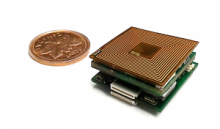The inventions contained in this opportunity include implantable electronic devices, novel machine learning techniques, and neural networks that are used to effectively process data, allowing for on-chip noise reduction, feature extraction, classification, pattern recognition to deliver targeted, personalized prediction and responsive stimulation. Power is provided to all the blocks of this microsystem using wired or wireless (inductive) links.
The implantable system on a chip (SoC) has neural recording/stimulation channels uniquely designed to maximize power efficiency, and features wireless power and data transfer.
Developed in the Intelligent Sensory Microsystems Lab led by Electrical and Computer Engineering Prof. Roman Genov, the multidisciplinary team uniquely focuses on both the hardware and software aspects of the SoC and includes world-class collaborators in neurosurgery, artificial intelligence, biomaterials, and biomedical, electrical, computer, mechanical, and industrial engineering
Benefits
Our approach vs. current neurostimulators:
- Delivers responsive, targeted stimulation vs. ongoing, continuous stimulation
- Features intelligent, on-chip processing that reduces the computational burden and increases energy efficiencies
- Does not require bulky externally-connected sensors and associated packaging
- Is wire-free and battery-free
- Has low signal-to-noise ratio
OPPORTUNITY
These devices and data processing methods can be used to predict/detect onset of a targeted physiological event. Such decision triggers an arbitrary subset of electrical/optical/chemical stimulators back to the physiological system. Alternatively, recorded signals or/and the output of the processing unit could be transmitted to a computer base station using wired or wireless links.
STATUS
- Patent applications now available for licensing:
- The SoC has been validated in in vivo epilepsy monitoring (seizure detection) and treatment (seizure suppression) experiments.





